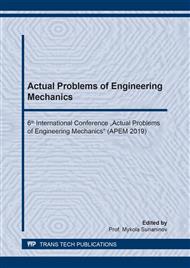[1]
E.E. Kazakova, O. N. Skorokhodova, Water-dispersions acrylic paint and varnish materials for construction purposes, Moscow, (2003).
Google Scholar
[2]
V.P. Lobkovsky, Water-dispersion paints for protection against corrosion, Russian Coatings Journal. (2011) 44-47.
Google Scholar
[3]
V.P. Selyaev, Yu.M. Bazhenov, Polymer coatings for concrete and reinforced concrete structures, Saransk, (2010).
Google Scholar
[4]
Y. Danchenko, V. Andronov, T. Obizhenko, A. Kosse and I. Khmyrov, Intern. J. of Eng. and Tech. (UAE). 7(4.3) 3 (2018) 279-283.
Google Scholar
[5]
Y. Danchenko, V. Andronov, E. Barabash, T. Obigenko, E. Rybka and R. Meleshchenko, Eastern-Europ. J. of Enterprise Tech. 6, 12 (90) (2017) 4-12.
DOI: 10.15587/1729-4061.2017.118565
Google Scholar
[6]
L. Vakhitova, A. Zavertatnyy, F+ S: fare and security, 45 (3) (2010) 64-66.
Google Scholar
[7]
N.N. Zhdanov, R.M. Garipov and A.I. Khasanov, Bulletin of the Technological University, 17 (16) (2014) 78-80.
Google Scholar
[8]
N. Saienko, D. Demidov and M. Myagkikh, Scientific Bulletin of Civil Engineering, 86 (4) (2016) 154-157.
Google Scholar
[9]
V.N., Kupriyanov, A.S. Petrov, News of the Kazan State University of Architecture and Engineering, 2 (24) (2013) 126-131.
Google Scholar
[10]
І.M. Kasyanenko, V.Yu. Kramarenko, Issues of Chemistry and Chemical Technology, 2 (2016) 67-72.
Google Scholar
[11]
V.F. Stroganov, I.V. Bezchvertnaya and M.O. Amelchenko, News of the Kazan State University of Architecture and Engineering, 2 (20) (2012) 200-206.
Google Scholar
[12]
H.M. Künzel, Simultaneous heat and moisture transport in building components. One-and two-dimensional calculation using simple parameters, IRB-Verlag Stuttgart, (1995).
Google Scholar
[13]
H.M. Künzel, C. Fitz und M. Krus, Deutsches Institut für Normung, Beuth Verlag, (2011) 29-51.
Google Scholar
[14]
H.S. Katz, J.V. Milewski, Van Nostrand Reinhold Co, New York, (1978).
Google Scholar
[15]
N. Saienko, D. Demidov, Y. Popov, R. Bikov and V. Butskyi, Matec Web of Conferences, EDP Sciences, (230) (2018) 03017.
DOI: 10.1051/matecconf/201823003017
Google Scholar
[16]
N.V. Saienko, D.V. Demidov, Y.V. Popov and R.A. Bikov, Collection of scientific works: Ways of increasing the efficiency of construction in the conditions of formation of market relations, 1 (39) (2019) 127-132.
Google Scholar
[17]
M.S. Vinarsky, M.V. Lurie, Planning an experiment in technological research, Kiev, (1975).
Google Scholar
[18]
V.G. Blokhin, O.P Gludkin, A.I. Gurov and M.A. Khanin, Modern experiment: preparation, implementation, analysis of results, Moscow, (1997).
Google Scholar
[19]
D.V. Demidov, D.V. Demidov, R.A. Bikov, L.V. Saienko and K.O. Ilyenko, Integrated Technologies and Energy Conservation, 1 (2019) 52-60.
Google Scholar


